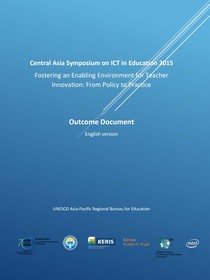Project-based learning and ICT
This article describes what “project-based learning” is and how it can be used to improve teaching and learning, and explains how ICT can be used as a tool in project-based learning.
February 2007
ICT tools for project-based learning

© UNESCO / A.Joyce
In project-based learning (PBL), students work in groups and learn about a subject by addressing a real-world problem or issue. The groups of students then create presentations to share with the rest of the class what they have learned.
Unlike conventional teaching approaches, which rely on the teacher to direct learning and control information flows, project-based learning gives students the freedom to explore a subject in a way that suits their learning needs.
Teachers and advocates of project-based learning believe that this form of learning enables students to:
- Develop greater knowledge about a subject.
- Become more motivated to learn.
- Improve their research and problem-solving skills.
- See how what they are learning at school can be used in real life.
In project-based learning, students try to answer a question – one that has relevance for them. For example, the question could be “What is the best kind of bridge to build over the river near our school?” or “What is the source of pollution in the river?”
Students then get into teams and decide how to approach a problem and what activities to pursue. They then conduct research to answer the question. This may involve studying several interrelated subjects at once. For example, in answering the question about the bridge, they may need to delve into mathematics, literature, history and physics.
The teams generally work on projects for a long period of time, at least six weeks, because they need to make an in-depth investigation into the subject.
There are often three phases in a project-based learning activity:
- Phase 1: Discuss the project topic and ask the students’ what they already know about the topic.
- Phase 2: In teams, students gather information from a variety of sources and synthesize, analyze, and derive knowledge from it. They also talk to experts and visit the site involved (if applicable).
- Phase 3: The teams then put together a presentation showing what they have learned (the answer to the question) and make a presentation to the rest of the class. Assessment is based on how much they've learned and how well they communicate it. Students also evaluate their peers for collaboration and presentation skills.
Project-based learning involves learning through experiences. These projects all engage students through hands-on experiences. They also allow for alternative approaches that address students' individual differences, variations in learning styles and abilities.
As well as teaching core content and raising awareness among students of their potential impact, PBL projects train students to take complex global issues and break them down into specific local action steps. It is important that projects are based in the real world because when students understand that their work is valuable for solving a real-world problem, or that their work will impact others, they are motivated to work hard. This type of learning is valuable because it is connected to real-world issues and enables students to demonstrate their knowledge in a practical way.
Project-based learning also requires students to develop skills such as collaboration and reflection. According to research studies, PBL helps students to improve their social skills improve and often leads to reduced absenteeism and fewer disciplinary problems in class. Students also become more confident talking to groups of people, including adults.
Project-based learning also increases enthusiasm for learning. When children are excited and enthusiastic about what they are learning, they often get more engaged in the subject and then expand their interest to other subjects. Enthusiastic students tend to retain what they learn, rather than forget it as soon as they have passed a test. Children who are excited about learning also tend to make connections between subjects and can apply what they have learned to other problems.
One reason that project-based learning is not very widespread is because teachers and parents were not taught in that way and prefer to utilize more conventional forms of teaching. However, when teachers and parents see how much children can learn through project-based learning and how excited and enthusiastic students are about learning, they often become ardent converts to PBL.
In project-based learning, a learner-centred approach, the teacher's role is to guide and advise students, rather than direct them.
ICT are effective tools for project-based learning. Students can use tools such as word processing software, spreadsheets and databases to perform tasks such as drafting essays, analyzing numerical data, and keeping track of collected information.
In addition, students can use the Internet for research and use online applications and tools, such as e-mail, e-forums, wikis and blogs to facilitate communication and collaboration with others. They can also utilize online journals for developing their ideas, and can create websites and presentations to display what they have learned.
Further information:
- Facilitating Effective ICT-pedagogy Integration (Project)
- Start with the Pyramid
http://www.edutopia.org/php/article.php?id=Art_884&key=037 - Project-Based Learning: a Primer
http://www.techlearning.com/db_area/archives/TL/2003/01/project.php
http://www.techlearning.com/db_area/archives/TL/2003/01/project6.php
Related articles:
- UNESCO digital-learning kit for teachers
http://www2.unescobkk.org/education/ict/v2_2/detail.asp?id=51340 - Learner-centred education
http://mettleweb.unimelb.edu.au/guide/principles.html - Waking up to new learning styles
http://www.bangkokpost.net/education/site2004/cvjn2904.htm - Blogs and wikis – are they useful in schools?
http://www.unescobkk.org/index.php?id=5323 - ICT and Pedagogy
http://www.unescobkk.org/index.php?id=ict_pedagogy
The “ICT in Education” Announcement e-newsletter:
- UNESCO Announcement e-newsletter
www.unescobkk.org/education/ict/enewsletter


